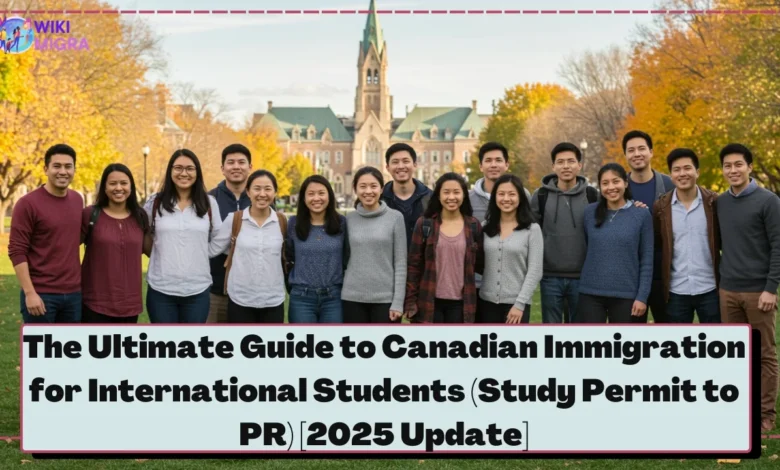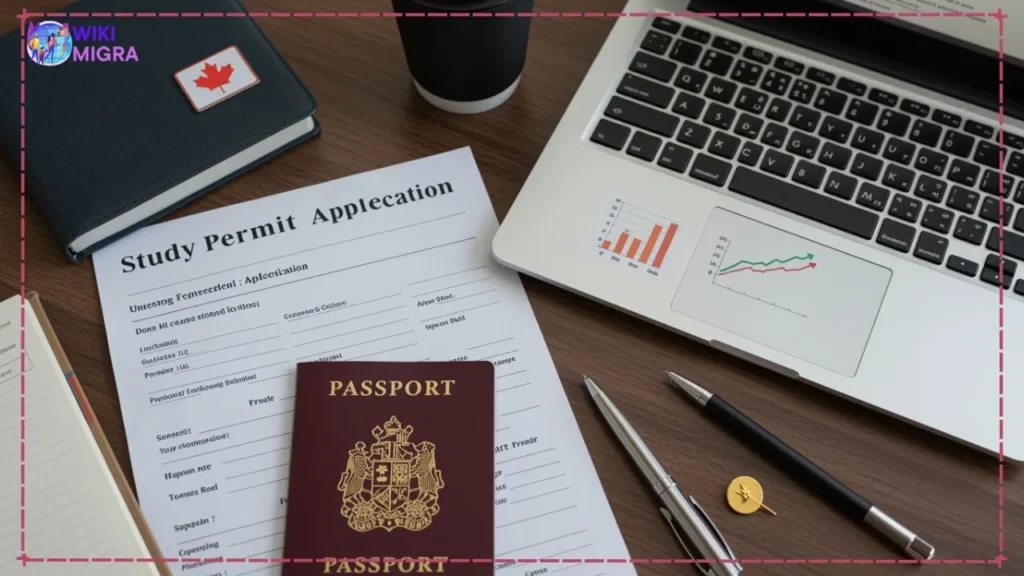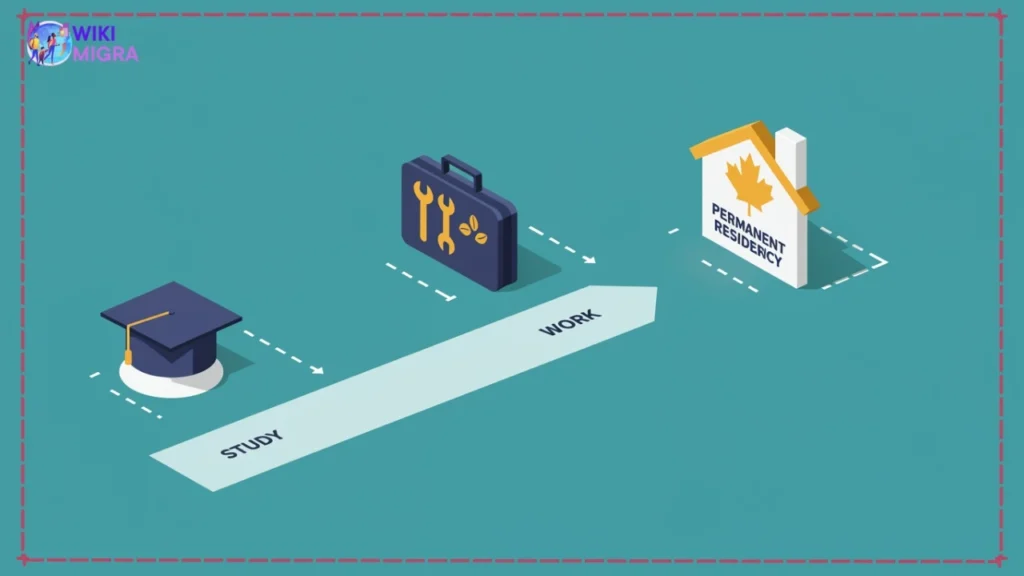The Ultimate Guide to Canadian Immigration for International Students (Study Permit to PR) [2025 Update]

Dreaming of studying in Canada and potentially making it your long-term home? You’re not alone. Canada’s world-class education system, vibrant multicultural cities, high quality of life, and welcoming attitude make it a top destination. But navigating the path from acceptance letter to potential permanent resident can feel complex. This is a crucial aspect of Canadian immigration for international students. That’s where this guide comes in.
We understand the journey because we specialize in helping students unlock global education opportunities, particularly focusing on Canadian immigration for international students. This isn’t just another article; it’s your comprehensive roadmap covering the entire lifecycle – essential information for anyone considering Canadian immigration for international students. We detail the journey from securing your initial Study Permit, through your studies and post-graduation work, right up to exploring pathways to Permanent Residency (PR). This guide aims to demystify the process, covering the steps from Canadian student visa to permanent residence. We’ll break down complex requirements, provide actionable tips, and point you to crucial official resources for Canadian immigration for international students.
Think of this as your trusted companion for understanding the complete Canadian immigration for international students process. Let’s embark on this exciting journey together!
Why Choose Canada for Your Studies and Future? A Pillar of Canadian Immigration for International Students
Before diving into the “how,” let’s quickly touch upon the “why.” What makes Canada such a compelling choice, especially regarding Canadian immigration for international students?
- Academic Excellence: Canadian universities and colleges consistently rank among the best globally, offering diverse programs across various fields – a strong foundation for future success.
- Multicultural & Welcoming Environment: Canada embraces diversity. You’ll find vibrant communities from all over the world, making it easier to feel at home, a key factor in positive Canadian immigration for international students experiences.
- Safety and Quality of Life: Known for its safety, political stability, and high living standards, Canada offers a secure environment to live and learn.
- Post-Graduation Opportunities: Crucially for many pursuing Canadian immigration for international students, Canada offers clear pathways for international graduates to gain valuable work experience (like the PGWP) and potentially transition from a Canadian student visa to permanent residence.
- Bilingual Nation: With English and French as official languages, Canada offers a unique opportunity to live and learn in a bilingual setting.
Now, let’s get into the practical steps fundamental to Canadian immigration for international students.
Phase 1: The Study Permit – Your Entry Ticket in the Canadian Immigration for International Students Process

The foundation of your journey within the Canadian immigration for international students framework is the Study Permit. This official document, issued by Immigration, Refugees and Citizenship Canada (IRCC), allows you to legally study at a Designated Learning Institution (DLI) in Canada. Obtaining this permit is the first major hurdle in the Canadian immigration for international students pathway.
What is a Study Permit vs. a Visa? (Clearing the Confusion in Student Immigration)
This is a common point of confusion for those navigating Canadian immigration for international students!
- Study Permit: This is not a visa. It’s the official document authorizing you to study in Canada for a specific period. You typically receive the actual permit document upon arrival in Canada. It’s central to your status.
- Temporary Resident Visa (TRV) or eTA (Electronic Travel Authorization): Depending on your country of citizenship, you might also need one of these to enter Canada. The TRV is a sticker placed in your passport. An eTA is electronically linked to your passport. When you apply for a study permit from outside Canada, the visa or eTA application is usually processed automatically alongside it if needed. These are entry documents, while the study permit authorizes your stay for study purposes – a key distinction in Canadian immigration for international students.
Think of it this way: The TRV/eTA gets you to the door (Canada’s border), and the Study Permit lets you stay inside for your studies, forming the base of your temporary residence status in the Canadian immigration for international students context.
Eligibility Requirements for a Canadian Study Permit: The Gatekeepers
Meeting the study permit requirements is crucial for a successful start to your Canadian immigration for international students journey. IRCC needs to be convinced that you are a genuine student who meets all conditions. Here’s a breakdown:
- Acceptance Letter from a Designated Learning Institution (DLI)
- This is non-negotiable for Canadian immigration for international students. You must have an official letter of acceptance (LOA) from a school approved by its province or territory to host international students.
- Action: Verify your chosen school is on the official DLI list Canada. You can find it here: [Link to Official IRCC DLI List]. Your LOA contains vital information needed for your application, underpinning your eligibility.
- Proof of Financial Support: A Core Requirement
- Demonstrating adequate funds is a cornerstone of Canadian immigration for international students. You must prove you have enough money to cover your:
- Tuition feesLiving expenses for yourself (and any family members coming with you)Return transportation for yourself (and family members)
- Demonstrating adequate funds is a cornerstone of Canadian immigration for international students. You must prove you have enough money to cover your:
- Intent to Leave Canada (Temporary Intent)
- As a temporary resident under the rules of Canadian immigration for international students, you must satisfy the visa officer that you will leave Canada at the end of your authorized stay (i.e., when your studies are complete and your permit expires, unless you obtain further authorization like a PGWP or PR). This is known as dual intent – having the intent to come temporarily while potentially seeking permanent residence later is acceptable, but your primary purpose for this application must be study.
- How to Demonstrate Ties: This involves showing strong connections to your home country, such as family ties, property ownership, job prospects back home, financial assets, etc. Be prepared to explain why you chose Canada for studies and how it fits into your future plans, clearly addressing this key aspect of Canadian immigration for international students.
- Medical Exam Requirements
- Depending on your country of residence or recent travel history, a medical examination by an IRCC-approved panel physician might be required as part of the Canadian immigration for international students checks.
- You can either do this before applying (upfront medical) or wait for instructions from IRCC after submitting your application. Doing it upfront can sometimes speed up processing.
- Biometrics (Fingerprints and Photo)
- Most applicants pursuing Canadian immigration for international students via study permits need to provide biometrics. You’ll receive instructions on where and how to do this after submitting your application and paying the fee.
- No Criminal Record
- Admissibility is key. You must be law-abiding and pose no security risk to Canada. You might need to provide police certificates as part of the Canadian immigration for international students background check.
The Study Permit Application Process (Step-by-Step Guide)
Applying involves several steps, primarily done online through the IRCC secure account. Understanding this process is vital for successful Canadian immigration for international students.
- Gather Your Documents: This is the most time-consuming part. Create a checklist for your Canadian immigration for international students application!
- Official Letter of Acceptance (LOA) from your DLI.
- Valid Passport.
- Proof of Financial Support (detailed).
- Letter of Explanation (SOP – Statement of Purpose): Crucial for explaining your motivations and plans related to Canadian immigration for international students.
- Passport-sized photos.
- Medical Exam proof (if done upfront).
- Police Certificates (if required).
- Application Forms.
- Application Fee Payment Receipt.
- Biometrics Fee Payment Receipt.
- Custodianship Declaration (for minors).
- Quebec Acceptance Certificate (CAQ) – If studying in Quebec.
- Provincial Attestation Letter (PAL) – Required for most post-secondary applications as of Jan 22, 2024. Check IRCC for details/exemptions.
- Create/Use Your Online IRCC Secure Account: Most applications are submitted electronically. This portal guides you through the specific requirements for your Canadian immigration for international students application. [IRCC Secure Account Portal]
- Complete Forms and Upload Documents: Fill out all required forms truthfully and accurately. Upload high-quality scans. Accuracy is paramount in the Canadian immigration for international students process.
- Pay the Fees: Pay the application processing fee and the biometrics fee online. Keep the receipt! [Official IRCC Fees Page]
- Submit the Application: Double-check everything before hitting submit.
- Give Biometrics: If required, attend your appointment at a Visa Application Centre (VAC).
- Wait for Processing: Processing times vary. Check the official IRCC study permit processing time tool for estimates relevant to Canadian immigration for international students: [IRCC Processing Time Tool]
- Receive a Decision:
- Approval: You’ll receive a Port of Entry (POE) Letter of Introduction and a TRV/eTA if needed. This approval is a major milestone in your Canadian immigration for international students journey. You present the POE letter upon arrival to get your Study Permit.
- Refusal: You’ll receive a letter explaining the reasons. Understand these carefully before deciding next steps. Refusals are a setback but often addressable in the Canadian immigration for international students process.
Tips for a Strong Application & Common Refusal Reasons in Student Immigration
- Be Truthful and Consistent: Accuracy is vital for credibility in all Canadian immigration for international students applications.
- Write a Compelling Letter of Explanation (SOP): Clearly articulate your goals and address potential concerns. This letter shapes the officer’s view of your application.
- Provide Strong Proof of Funds: Convince the officer of your financial capacity. This is a frequent point of scrutiny in Canadian immigration for international students.
- Demonstrate Strong Ties to Home Country: Address the temporary intent requirement clearly.
- Apply Early: Factor in processing times, a practical tip for managing Canadian immigration for international students.
- Check DLI Status & PAL Requirements: Ensure compliance with institutional and provincial rules.
Common Refusal Reasons: Insufficient proof of funds, weak ties/doubts about intent, unclear study plan, admissibility concerns, incomplete application, failure to meet PAL requirements (if applicable). Understanding these helps applicants strengthen their Canadian immigration for international students case.
Phase 2: While You Study – Maintaining Status & Working within the Framework

Congratulations, you’ve arrived! Now, maintaining your status is crucial for your ongoing Canadian immigration for international students eligibility.
Conditions of Your Study Permit
Your study permit lists conditions you must follow:
- Enroll and remain enrolled at your DLI.
- Actively pursue your studies.
- Make progress towards completion.
- Respect study permit conditions (work limits, etc.).
- Leave Canada at the end of your authorized stay or get further authorization (like PGWP).
Important: Non-compliance can jeopardize your status and future Canadian immigration for international students prospects. If changing DLIs, notify IRCC.
Working While Studying (Know the Rules!)
Working part-time is common for those pursuing Canadian immigration for international students. The rules are specific:
- On-Campus Work: Allowed without a separate work permit if you’re a full-time student at an eligible DLI.
- Off-Campus Work:
- Eligibility: Requires a valid study permit, full-time enrollment at a DLI in an eligible program (min. 6 months, leading to degree/diploma/certificate), and the work authorization condition printed on your permit.
- Hour Limits (Crucial Checkpoint): Historically 20 hours/week during sessions, full-time during breaks. Temporary policies regarding hours fluctuate. Always verify current IRCC policy impacting Canadian immigration for international students.
- Social Insurance Number (SIN): Needed to work. Apply at Service Canada once eligible.
Renewing or Extending Your Study Permit
If needed, apply to extend before expiry. Applying before expiry grants “maintained status,” allowing you to continue studying while waiting – a key mechanism in Canadian immigration for international students.
Phase 3: After Graduation – The Post-Graduation Work Permit (PGWP): Bridging to the Next Stage

This is a cornerstone, perhaps the most critical bridge, in the Canadian immigration for international students pathway towards long-term settlement, often facilitating the Canadian student visa to permanent residence transition.
What is the PGWP?
- An open work permit allowing work for almost any employer.
- A vital tool for gaining Canadian work experience needed for PR.
- A one-time opportunity, pivotal for Canadian immigration for international students.
PGWP Eligibility Criteria (Crucial Details for PR Aspirants!)
Meeting the PGWP eligibility criteria precisely is vital for anyone serious about Canadian immigration for international students leading to PR. You must have:
- Completed an eligible program at an eligible Canadian DLI. Crucially, not all programs/DLIs qualify! Research this before starting studies. Public post-secondary or qualifying private institutions are key.
- Completed a program of study of at least 8 months.
- Maintained full-time student status (with limited exceptions).
- Graduated from an eligible institution/program.
- Applied within 180 days of official program completion confirmation.
- Held a valid study permit recently.
Warning: Errors here can derail Canadian immigration for international students plans. Part-time study (usually), unauthorized breaks, or non-eligible programs/DLIs lead to ineligibility.
How and When to Apply for the PGWP
- Apply within 180 days of confirmation (transcript/letter).
- Apply online (in or outside Canada).
- Maintain valid status if applying from within Canada. Applying before study permit expiry often allows work while waiting. This timing is crucial for a smooth transition in the Canadian immigration for international students process.
PGWP Duration
- Program 8 months to < 2 years: PGWP = program length.
- Program ≥ 2 years: PGWP up to 3 years. This longer duration significantly benefits Canadian immigration for international students seeking PR.
- Multiple Programs: Can combine lengths (up to 3 years max).
Working on a PGWP
The open nature allows gaining skilled work experience (NOC TEER 0, 1, 2, 3), directly contributing to PR eligibility under programs like CEC – a major goal of Canadian immigration for international students.
Phase 4: Pathways to Permanent Residency (PR) – The Immigration Goal for Many Students

This is where the focus shifts firmly towards long-term settlement, the ultimate aim for many pursuing Canadian immigration for international students and seeking to transition from a Canadian student visa to permanent residence.
From Temporary to Permanent within Canadian Immigration
Canada values the skills and experience of former international students. Economic immigration programs are the primary route for achieving the Canadian student visa to permanent residence goal.
Express Entry System: The Main Federal Route
Express Entry manages applications for FSWP, FSTP, and importantly for former students, the CEC. It’s a points-based system central to federal Canadian immigration for international students pathways.
- Canadian Experience Class (CEC): The Key Pathway for Graduates
- CEC requirements target those with Canadian skilled work experience, making it ideal for PGWP holders. This is often the most direct international student PR pathway.
- Key Eligibility: 12+ months full-time (or equivalent) skilled work experience (TEER 0, 1, 2, 3) in Canada within the last 3 years (gained post-graduation, typically on PGWP), required language proficiency (CLB 7/5), plan to live outside Quebec.
- How it Works: Meet criteria -> Create Express Entry profile -> Enter pool. This is a standard procedure in Canadian immigration for international students aiming for PR.
- Comprehensive Ranking System (CRS) Points
- Your profile gets a CRS score based on age, education (Canadian study = bonus points!), language, Canadian work experience (highly valued!), partner factors, skills transferability, and additional points (PNP nomination = 600 points!, job offer, French, sibling). High scores lead to ITAs for PR. Maximizing CRS is key strategy in Canadian immigration for international students.
Provincial Nominee Programs (PNPs): Tailored Provincial Options
PNPs allow provinces to nominate candidates meeting their specific needs, often offering dedicated streams for international graduates, providing alternative Canadian immigration for international students routes.
- Explanation: Provinces nominate candidates for PR based on local labour market needs. Many streams favour graduates from their institutions.
- How it Works: Apply directly (Base) or through Express Entry (Enhanced). Nomination adds 600 CRS points (Enhanced) or allows paper-based PR application (Base). PNPs are a crucial component of the overall Canadian immigration for international students landscape.
- Examples: OINP (Ontario), BC PNP, etc., have graduate streams. Check provincial websites (e.g., [Ontario OINP Site], [BC PNP Site]). These programs greatly influence Canadian immigration for international students outcomes.
Other Potential Pathways Towards Permanent Residence
- Quebec Immigration: Separate system (e.g., PEQ for graduates).
- Specific Pilot Programs: Atlantic Immigration Program, Rural/Northern pilots. These offer niche opportunities within Canadian immigration for international students.
Key Considerations & Practicalities for Your Canadian Immigration Journey

Successful Canadian immigration for international students requires looking beyond applications.
- Choosing the Right DLI and Program: Impacts PGWP eligibility and PR prospects. Research alignment with skilled occupations (TEER 0-3). This strategic choice is fundamental to long-term Canadian immigration for international students success.
- Proof of Funds (Continuously): Financial stability remains important. Revisit proof of funds student visa Canada standards if extending status.
- Bringing Family: Spouse may get open work permit; children may study. Factor family into your Canadian immigration for international students planning.
- Healthcare: Understand provincial rules (public vs. private insurance).
Recent Policy Updates & Changes [2025] – Critical for Canadian Immigration for International Students
The landscape of Canadian immigration for international students is dynamic. Stay informed!
- Proof of Funds Requirements: Increased significantly Jan 1, 2024. Annual adjustments expected.
- Off-Campus Work Hours: Monitor IRCC for current rules; temporary policies may end/change. This directly impacts the student experience within Canadian immigration for international students.
- PGWP Eligibility/Rules: Watch for potential changes (e.g., distance learning impacts).
- Express Entry Draws: Category-based draws target specific occupations/attributes, affecting Canadian immigration for international students PR chances.
- DLI Attestation Letters (PALs): Required for most new applications since Jan 22, 2024. A major recent change in Canadian immigration for international students.
- Intake Caps: Temporary 2-year cap affects non-degree post-secondary programs. Understand its impact on your plans.
Recommendation: Regularly check the official IRCC website (www.canada.ca/immigration) for the latest on Canadian immigration for international students.
Frequently Asked Questions (FAQ) on Canadian Immigration for International Students
- Q1: Can I work full-time during scheduled breaks?
- A1: Generally yes, if eligible for off-campus work and meeting full-time enrollment criteria before/after the break. Verify current policy, as rules impacting Canadian immigration for international students can change.
- Q2: Can my spouse work while I study?
- A2: Often yes, via an open work permit if you meet DLI/program requirements. A significant benefit for families pursuing Canadian immigration for international students.
- Q3: What if my study permit is refused?
- A3: Review refusal reasons carefully. Address concerns and consider reapplying. Refusals are part of the Canadian immigration for international students reality for some; understanding why is key.
- Q4: How long is the path from Canadian student visa to permanent residence?
- A4: Varies greatly. Post-PGWP, gaining 1 year+ skilled work, meeting language/CRS thresholds, and PR processing takes time (often 1.5-3+ years total after starting work). There’s no fixed timeline in the Canadian student visa to permanent residence journey.
- Q5: Does co-op work count for CEC?
- A5: Generally no. CEC requires skilled work experience gained after studies, typically on a PGWP, a critical point for Canadian immigration for international students aiming for PR via CEC.
- Q6: Do I need a consultant for Canadian immigration for international students?
- A6: Not required. Use official IRCC resources. Reputable, licensed help (RCIC/lawyer) is an option for complex cases but beware of unauthorized agents.
- Q7: What’s the Student Direct Stream (SDS)?
- A7: An expedited study permit stream for residents of certain countries meeting specific financial (GIC), language (IELTS 6.0+), and upfront requirements. It aims for faster processing within the Canadian immigration for international students application system.
Your Canadian Dream: The Ongoing Journey of Student Immigration
Navigating Canadian immigration for international students is a marathon, not a sprint, but it’s an achievable dream. From meeting study permit requirements and proving proof of funds, to leveraging PGWP eligibility for work experience, and finally charting your international student PR pathway towards the goal of Canadian student visa to permanent residence – each phase demands diligence. Success in Canadian immigration for international students hinges on understanding the rules, staying informed, and meticulous preparation.
This guide provides the map for your Canadian immigration for international students journey; your dedication drives the progress.
Ready to take the next step in your Canadian immigration for international students plan?
- Explore Programs: Research DLI/program alignment with PGWP/PR goals.
- Assess Finances: Plan for costs and document proof of funds.
- Stay Updated: Bookmark IRCC and monitor news affecting Canadian immigration for international students.
Some articles that may help you:
- Your Ultimate Guide to Canadian Study Permit Requirements [Planning for 2025] – Get a granular look at every requirement.
- How to Canada Student Visa Apply Online [Step-by-Step] – Follow our visual guide through the IRCC portal.
- 10 Essential Steps to Apply for Your Post Graduation Work Permit (PGWP): Complete Guide for 2025
We wish you the very best on your exciting journey through Canadian immigration for international students!





